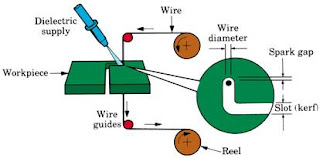 In AJM,a mixture of compressed gas and abrasive particles are used and it is sprayed with high velocity on the work surface.Compressor is used to produce high pressure and then this high pressure gas is guided to a vibrating mixing chamber through different valve mechanisms.the amplitude of vibration decides how much of abrasive particles get mixed with the compressed gas.then this mixture is transformed to a high velocity jet through a nozzle of reducing cross-section.In order to eliminate the wear of nozzle,it is usually made with tungsten carbide.
In AJM,a mixture of compressed gas and abrasive particles are used and it is sprayed with high velocity on the work surface.Compressor is used to produce high pressure and then this high pressure gas is guided to a vibrating mixing chamber through different valve mechanisms.the amplitude of vibration decides how much of abrasive particles get mixed with the compressed gas.then this mixture is transformed to a high velocity jet through a nozzle of reducing cross-section.In order to eliminate the wear of nozzle,it is usually made with tungsten carbide.Specifications:
- Gas used:Air,Nitrogen,Co2
- Abrasive particles:Aluminium oxide powder,Silicon-carbide,Glass powder,Dolomite(light cleaning),Sodium carbonate(Using for extra fine cleaning).
- Jet velocity:300M/S
- Nozzle pressure:0.5N/MM2





